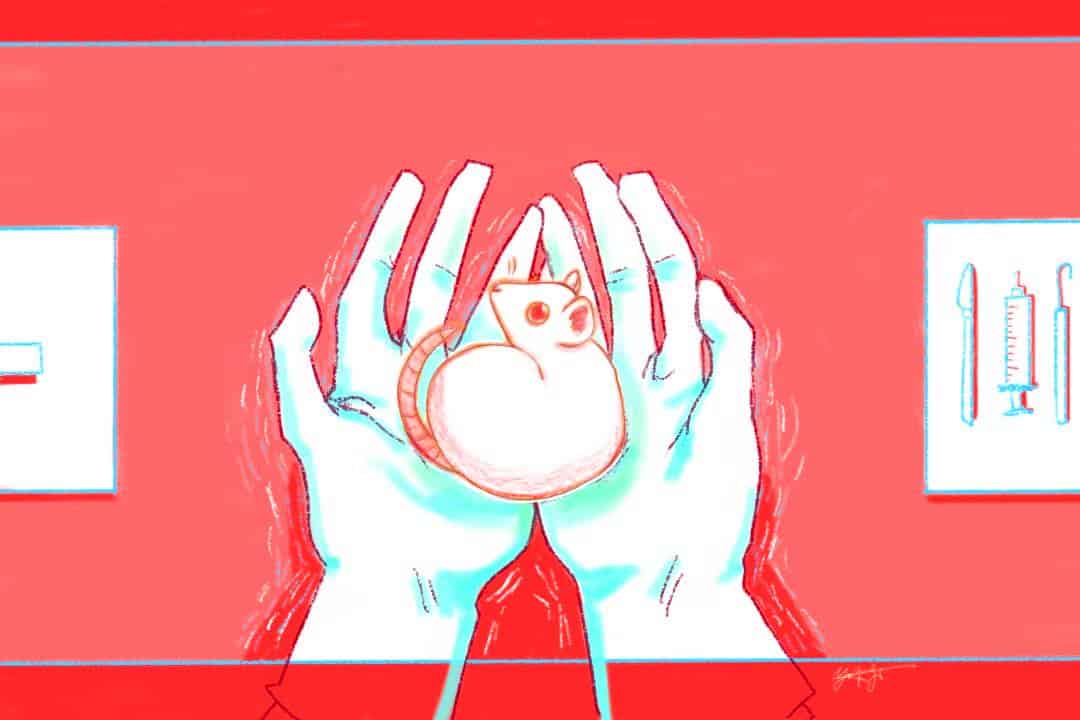Scrubs tied, mask on, latex gloves snug — I felt like a surgeon. Ready, I walked with my classmates into a small room in the basement of the Medical Sciences Building for our animal care training session. We gathered around a table that was covered in blueish-white fabric that reminded me of diapers. Looking down at the table, we were prepared.
A mouse carcass was suddenly plopped in front of me. With soft grey hair, closed eyes, and little teeth peeking out, it was splayed in such a way that its lifelessness was clear.
“Get used to its weight. Pick it up by the tail,” the animal care staff told us.
Get used to its weight? I watched as my classmates eagerly pinched dead mice by their tails, suspending them upside down. “Huh,” I thought. I slowly brought my gloved index finger to the mouse, poked its back, and pulled back my hand into an arms-crossed, surgeon-ready position. “It’s dead,” I told myself. “It’s a mouse,” I tried. “It’s for science.” I breathed in, immediately regretting it — the carcasses, mouse food, urine, formaldehyde. My fingers swooped in, pinched the mouse by its tail, and lifted. It was heavier than expected. I quickly placed the mouse back down. “Good job,” I told myself.
“Okay, now try the restraint technique. Hold the tail with one hand, press on the back of the mouse with the other, push down and toward the head. Make sure the mouse is immobile. Pull back its skin around the neck, and hold the loose skin in your hands. Pick it up, stomach bare.”
I looked around at some classmates attempting this technique, securing the mouse, showing it off, and leaving its stomach vulnerable. Others were more hesitant. I picked up my dead mouse by the tail again — I wasn’t yet used to its weight. A few more times. I put it down, looking at its body, absorbing the lifelessness of this thing in front of me. I put my fingers on its back, feeling its ribs and soft organs.
Scientists use mice for experimentation across a wide range of fields, from physiology to psychology. Reading countless articles, I always thought I was fine with that. Using animals seemed like the right thing to do; they allow us to learn about blood and bones, to understand illnesses and cure them. And I still believe all this. Science relies on experimental models. I began to wonder, however, if I could still be supportive of the use of animals for research if I couldn’t do it myself.
As quickly as the dead mouse appeared, it was taken away and replaced by one that was alive. I was still not used to its weight. I still hadn’t moved past the first step — picking up the mouse. My two hands rested on each side of the cage, as if I were about to open it, but I didn’t. The mouse scurried around, nibbling at things and running into its red house. I stood watching it, sweating.
“You’ll get used to it,” one of the instructors told me. “It gets easier. I had trouble at the beginning, too.”
“Okay, that’s good,” I thought. “I have hope.” I could still play the fearless surgeon, but as the day went on, as the mice’s ears were clipped, their noses squished by cylindrical devices meant to keep them still, as we collected blood from their tails every 15 minutes to measure their glucose levels, I began to wonder whether this was something that I wanted to get used to.
The tails of the mice were supposed to be anaesthetized before we clipped them to draw blood. I took scissors to the tip and snipped. The mouse squealed and squirmed. I looked up at my instructor in panic, bloody scissors in hand and pained mouse restrained.
“Hmm, the anaesthetizing agent might not have taken effect yet,” she said. I was struck by how unaffected she was.
I understand that to do this work you must learn to be undisturbed. You get used to it, and I watched myself and my classmates get used to it. The flinch at the blood draw, the squeal of the mouse when stuck in a tight tube, the desperate squeezing and scratching — it became less disturbing. “This seems good,” I thought. “I’m becoming more of a scientist.”
But I paused. What does it mean for me to get used to suffering? Even though it’s ‘just a mouse,’ even though it’s for science? Did I want all this to become second nature? I pushed harder at the voice telling me that what we were doing was a little cruel. But maybe I didn’t want to lose that voice. What else might I have to get used to? It became clear that I am — we all are — vulnerable to anaesthetization.
Do I close my eyes and bear it? Do I join the team of people, of scientists, who are used to it? Do I convince myself of its value? Or do I stand still, arms crossed, in protest?
I don’t have answers; I have not gotten used to the weight, and I am not sure where I will go from here. But I know that I don’t want the donning of latex gloves to mean protection from disturbance. I want to continue to feel uncomfortable, distressed, and stunned.


